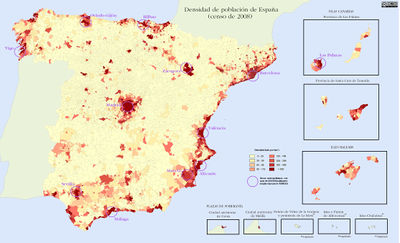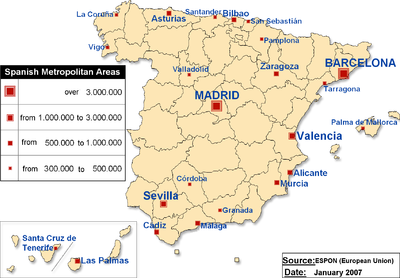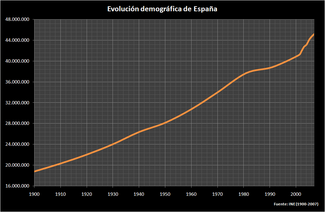Demographics of Spain
This article is about the demographic features of the population of Spain, including population density, ethnicity, education level, health of the populace, economic status, religious affiliations and other aspects of the population.
Spain has 46,157,822 inhabitants according to 2008 census[1]. Its population density, at 91.4/km² (229/sq. mile), is lower than that of most Western European countries. With the exception of the capital, Madrid, the most populous regions lie around the coast.
The population of Spain doubled during the twentieth century, but the pattern of growth was extremely uneven due to large-scale internal migration from the rural interior to the industrial cities, a phenomenon which happened later than in other Western European countries. No fewer than eleven of Spain's fifty provinces saw an absolute decline in population over the century.

The last quarter of the century saw a dramatic fall in birth rates. Spain's fertility rate of 1.37 (the number of children the average woman will have during her lifetime) is lower than the EU average, but has climbed every year since the late 1990s. The birth rate has climbed in 10 years from 9.10 births per 1000 people per year in 1996 to 10.9 in 2006.
Spain has no official religion. The Spanish Constitution of 1978 abolished the Roman Catholic Church as the official state religion, while recognizing the role it plays in Spanish society. About 70% of the population define themselves as Catholic, but 63% assert they almost never go to any religious service[2]
Contents |
Immigration and Demographic Issues
The population of Spain doubled during the twentieth century as a result of the spectacular demographic boom in the 1960s and early 1970s. After that time, the birth rate plunged through the 1980s and Spain's population became stalled, its demographics showing one of the lowest sub replacement fertility rates in the world, only second to Greece, Portugal, Hungary, Ukraine and Japan. Many demographers have linked Spain's very low fertility rate to the country's lack of any real family planning policy. Spain is the Western European country that spends least on family support (a paltry 0.5% of GDP). A graphic illustration of the enormous social gulf between Spain and the rest of Europe in this field is the fact that a Spanish family would need to have 57 children to enjoy the same financial support as a family with 3 children in Luxembourg.
In emigration/immigration terms, after centuries of net emigration, Spain, has recently experienced large-scale immigration for the first time in modern history. According to the Spanish government there were 5,220,000 foreign residents in Spain as of January 2008. Of these, more than 700,000 were Romanian, and well over half a million were Moroccan while the number of Ecuadorians was around half a million as well. Colombian population amounted to around 300,000. There are also a significant number of British (350,000 as of 2008, but more than one million are estimated to live permanently in Spain) and German (133,588) citizens, mainly in Alicante, Málaga provinces, Balearic Islands and Canary Islands. Chinese are estimated to number over 110,000. Immigrants from several sub-Saharan African countries have also settled in Spain as contract workers, although they represent only 4.08% of all the foreign residents in the country.
During the early 2000s, the mean year-on-year demographic growth set a new record with its 2003 peak variation of 2.1%, doubling the previous record reached back in the 1960s when a mean year-on-year growth of 1% was experienced.[3] This trend is far from being reversed at the present moment and, in 2005 alone, the immigrant population of Spain increased by 700,000 people [4].
Allegedly, the growing population of immigrants is the main reason for the slight increase in Spain's fertility rate [5]. From 2002 through 2008 the Spanish population grew by 8%, of which 6% were foreign.[6]
Metropolitan areas
The most important metropolitan areas in 2007 are:

- Madrid 5,603,285
- Barcelona 4,667,136
- Valencia 1,671,189
- Sevilla 1,499,673 (INE 2008)
- Bilbao 950,829
- Málaga 897,563
- Asturias (Gijón-Oviedo) 857,079
- Sabadell and Terrassa 817,641
- Alicante-Elche 748,565
- Zaragoza 731,803
- Vigo 662,412
- Las Palmas de Gran Canaria 616,903
- Bahía de Cádiz (Cádiz-Jerez de la Frontera) 615,494
- Santa Cruz de Tenerife 573,825
- Murcia 563,272
- Palma de Mallorca 474,035
- Granada 472,638
- San Sebastián 402,168
- Tarragona 406,042
- A Coruña 403,007
- Valladolid 400,400
- Santander - Torrelavega 391,480
- Cordoba 323,600
- Pamplona 309,631
Islands
Islander population:[8]
|
CIA World Factbook demographic statistics
The following demographic statistics are from the CIA World Factbook, unless otherwise indicated.
Population
46,157,822 (January 2008)
.png)

Age structure (2008 est.)
0-14 years: 14.4% (male 3,423,861/female 3,832,028)
15-64 years: 69.1% (male 16,185,5575/female 15,683,433)
65 years and over: 16.5% (male 3,238,301/female 4,394,624) (2008 est.)
Population growth rate
0.13% (2006 est.)
Birth rate
10.95 births/1,000 population (2008 est.)
Death rate
8.72 deaths/1,000 population (2008 est.)
Net migration rate
0.99 migrant(s)/1,000 population (2009 est.)
Sex ratio
at birth: 1.07 male(s)/female
under 15 years: 1.06 male(s)/female
15-64 years: 1.01 male(s)/female
65 years and over: 0.72 male(s)/female
total population: 0.96 male(s)/female (2006 est.)
Infant mortality rate
4.37 deaths/1,000 live births (2006 est.)
Life expectancy at birth
total population: 79.65 years
male: 76.32 years
female: 83.2 years (2006 est.)
Total fertility rate
1.39 children born/woman (2009 est.)
Nationality
noun: Spaniard(s)
adjective: Spanish
Ethnic groups
Definition of ethnicity or nationality in Spain is fraught politically. The term "Spanish people" (pueblo español) is defined in the 1978 constitution as the political sovereign, i.e. the citizens of the Kingdom of Spain. The same constitution in its preamble speaks of "peoples of Spain" (pueblos de España) and their respective cultures, traditions, languages and institutions.
The CIA Factbook (2008) exceptionally gives a racial description of "composite of Mediterranean and Nordic types" under "ethnic groups" instead of the usual breakdown of ethnic composition. This reflects the formation of the modern Kingdom of Spain by the accretion of several independent Iberian realms, i.e. Asturias, León, Galicia, Castile, Navarre, Aragon, Catalonia, Majorca, Valencia, Granada. The individual nationalities or peoples of these lands are the Asturians, Leonese, Galicians, Basques, Cantabrians, Castilians, Aragonese, Catalans, and Andalusians. The native Canarians are the descendants of the population of the Canary Islands prior to Spanish colonization in the 15th century. Also included are many Spaniard citizens who are descendents of people from Spain's former colonies, mostly from Equatorial Guinea, Argentina, Dominican Republic, Ecuador, Peru, Colombia, Western Sahara, Morocco and the Philippines. There is also a sizeable number of Spaniards of Middle Eastern, Eastern European, African and Chinese origins.
Native-born Spanish citizens of all races and ethnic groups make up 88% of the total population, and 12% are immigrants. Among the immigrants, around 57% of them come from Spain's former colonies in Latin America, Africa and Asia. The rest are mostly Eastern Europeans (especially Romanians, Bulgarians, Polish, Ukrainians and Russians), North and West Africans (notably Moroccans, Algerians, Senegalese, Nigerians and Cameroonians), Middle Eastern peoples, Indians, Pakistanis and Chinese, as well as a sizeable number of citizens from the European Union, mostly Portuguese, British and Germans.
Religions
Roman Catholicism is the largest religion in the country by far. According to a July 2009 study by the Spanish Center of Sociological Research about 70% of Spaniards self-identify as Catholics, 10% other faith, and about 20% identify with no religion. Most Spaniards do not participate regularly in religious services. This same study shows that of the Spaniards who identify themselves as religious, 58% hardly ever or never go to church, 17% go to church some times a year, 9% some time per month and 15% every Sunday or multiple times per week.[9] But according to a December 2006 study, 48% of the population declared a belief in a supreme being, while 41% described themselves as atheist or agnostic.[10]
Languages
- Spanish (official) 100% (89% mother tongue[11] )
- Catalan 16%[12] (9% mother tongue [11]) (co-official in Catalonia, Balearic Islands, and Valencia — see Valencian)
- Galician 7% (5% mother tongue [11]) (co-official in Galicia)
- Basque 1.6% (1% mother tongue [11]) (co-official in Basque Country and designated areas in Navarre).
- Aranese (a variant of Gascon Occitan) is co-official in Val d'Aran, a small valley in the Pyreenes.
Others with no official status:
- Asturian-Leonese (in the former Kingdom of León and Asturias)
- Aragonese (in the province of Huesca, Aragon)
Literacy
definition: age 15 and over can read and write
total population: 97.9% (2003 est.)
male: 98.7% (2003 est.)
female: 97.2% (2003 est.)
Educational system
About 70% of Spain's student population attends public schools or universities. The remainder attend private schools or universities, some of which are operated by the Catholic Church.
Compulsory education begins with primary school or general basic education for ages 6-16. It is free in public schools and in many private schools, most of which receive government subsidies. Following graduation, students attend either a secondary school offering a general high school diploma or a school of professional study in all fields — law, sciences, humanities, and medicine — and the superior technical schools offer programs in engineering and architecture.
References
- ↑ Instituto Nacional de Estadística de España. "Official Population Figures of Spain. Population on the 1st January 2008". http://www.ine.es/jaxi/menu.do?type=pcaxis&path=%2Ft20/e260&file=inebase&L=1. Retrieved 2008-02-05.
- ↑ CIS study, 2005. Interview to 2491 people. Questions 32 and 32a.
- ↑ Official report on Spanish recent Macroeconomics, including data and comments on immigration
- ↑ Source: Instituto Nacional de Estadística. Evolution of the foreign population in Spain since 1998[1]
- ↑ Source: Instituto Nacional de Estadística, Evolution of the global fertility rate between 1975 and 2005 [2]
- ↑ [3]
- ↑ "AUDES project". Grupo Alarcos. http://alarcos.inf-cr.uclm.es/per/fruiz/pobesp/dat/arc/areas-pob.xls. Retrieved 2008-08-14.
- ↑ La superficie de las islas vendrá dada en hectáreas salvo la de las mayores islas de los archipiélagos canario y balear, así como las Plazas de Soberanía.
- ↑ "Barómetro julio 2009, Centro de Investigaciones Sociológicas, Jul 2009". http://www.cis.es/cis/opencms/-Archivos/Marginales/2800_2819/2811/es2811.pdf. Retrieved 2009-10-16.
- ↑ Religion Important for Americans, Italians, Angus Reid Global Monitor, December 30, 2006
- ↑ 11.0 11.1 11.2 11.3 http://ec.europa.eu/public_opinion/archives/ebs/ebs_243_en.pdf
- ↑ Ethnologue report for Spain
See also
- Health in Spain
- Spain
- List of Spaniards
- Nationalities in Spain
External links
|
||||||||||||||
|
||||||||||||||||||||||||||